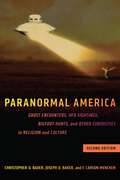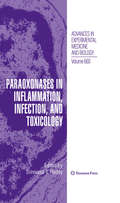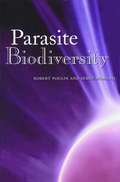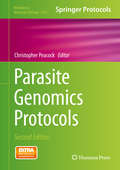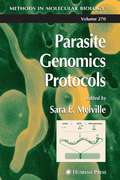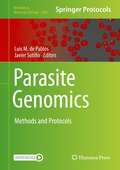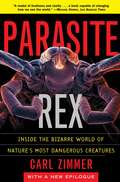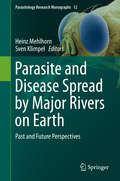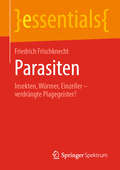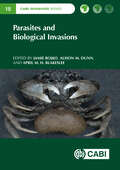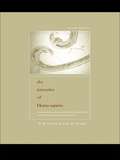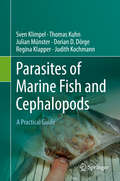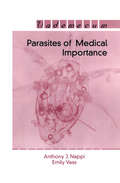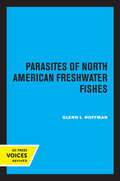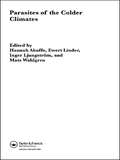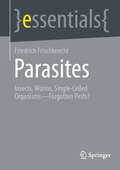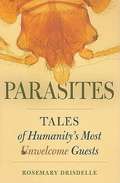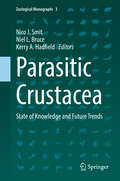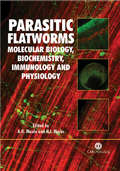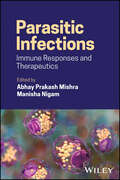- Table View
- List View
Paranormal America (second edition): Ghost Encounters, UFO Sightings, Bigfoot Hunts, and Other Curiosities in Religion and Culture
by F. Carson Mencken Christopher D Bader Joseph O BakerAn &“engrossing and intellectually stimulating&” portrait of the countless Americans who believe in paranormal phenomena (Journal of Religion and Culture). Popular culture makes clear that there&’s a seemingly insatiable public appetite for information and entertainment about what we call the paranormal, supernatural, or mystical. But how many Americans believe in the paranormal, and who are they? Based on extensive research and their own unique experiences, Christopher Bader, Joseph Baker, and Carson Mencken reveal that a significant number hold these beliefs, and that for better or worse, we undoubtedly live in a paranormal America.Paranormal America follows the authors as they participate in psychic and palm readings, have their auras photographed, join a Bigfoot hunt, follow a group of celebrity ghost hunters as they investigate claims of a haunted classroom, and visit a support group for alien abductees. The second edition also includes new and updated research based on findings from the Baylor Religion Survey regarding America&’s relationship with the paranormal. Drawing on these diverse and compelling sources of data, the book offers an engaging account of the social, personal, and statistical stories of American paranormal beliefs and experiences. It examines topics such as the popularity of paranormal beliefs in the United States, the ways in which these beliefs relate to each other, whether paranormal beliefs will give rise to a new religion, and how believers in the paranormal differ from &“average&” Americans. Brimming with fascinating anecdotes and provocative new findings, Paranormal America offers an entertaining yet authoritative examination of a growing segment of American religious culture. &“An engaging and eye-opening book that offers an abundance of new insights, dispelling some popular stereotypes and reaffirming others.&” —Roger Finke, Distinguished Professor of Sociology and Religious Studies, Pennsylvania State University
Paraoxonases in Inflammation, Infection, and Toxicology
by Srinivasa T. ReddyThe pivotal role of the Paraoxonases (PON) family in a variety of inflammatory diseases, e.g. atherosclerosis, in preventing the toxicity of organophosphorus insecticides and nerve agents and a variety of other compounds has made them an interesting target for both clinicians and scientists alike. Research into the paraoxonase (PON) family of enzymes (PON1, PON2 and PON3) has increased exponentially over the last five years especially following the initiation of paraoxonase conferences. The objectives of the 3rd ICP remains the same as the previous two conferences: to disseminate the latest aspects of research into the genetics, biochemistry, structural biology, regulation of PONs and their roles in inflammatory diseases e.g. atherosclerosis with expert lectures from 20 invited plenary lecturers and another 30-40 short and poster presentations from young investigators. The conference organizers anticipate a global attendance at the conference of between 150- 200 persons. Particular aspects of this conference will include the Bert N La Du Memorial Lecture, 3 Memorial Traveling Fellowships for Young Investigators and a round table discussion on the impact of the latest research on PON. UCLA provides a great venue for students, postdoctoral fellows and clinical scientists to interact with experts in the PON fields of study. The explosion of research into the PON family makes this a timely conference to review recent exciting advances in the field and provide an environment for cross-fertilization of ideas, particularly important for researchers new to the field.
Parascientific Revolutions: The Science and Culture of the Paranormal (Proximities)
by Derek LeeUnraveling the hidden influence of the paranormal on science, literature, and belief Telepathy, clairvoyance, precognition, and telekinesis: these attributes of the paranormal mind are widely dismissed as nonsense, but what can an exploration of such pseudoscientific phenomena tell us about accepted scientific and cultural thought? In Parascientific Revolutions, Derek Lee traces the evolution of psi epistemologies across the twentieth and twenty-first centuries to uncover how these ideas have migrated into scientific fields such as quantum physics and neurology, as well as diverse literary genres including science fiction, ethnic literature, and even government training manuals. Lee introduces the groundbreaking concept of &“parascience,&” a dynamic cultural space where ideas rejected by the scientific establishment blend with alternative strains of literary, mythic, and philosophical thought to regenerate and return to mainstream discourse. From early modernist works by James Joyce to postwar speculative fiction by Philip K. Dick to ethnofuturist narratives by Ruth Ozeki, Parascientific Revolutions demonstrates how cultural and intellectual currents reshape paranormal ideas over time. Examining psychic surveillance programs like Project Stargate and bizarre particles of extrasensory perception such as the psitron, Lee illustrates the ways paranormal concepts persist and evolve to influence culture. Presenting pseudoscience as an inevitable by-product of the scientific process, Parascientific Revolutions offers fresh insight into how the paranormal mind continually challenges our understanding of knowledge and belief. It invites readers to reconsider the boundaries between science and the unknown, revealing a world where speculative thought and empirical investigation are deeply intertwined. Retail e-book files for this title are screen-reader friendly with images accompanied by short alt text and/or extended descriptions.
Parasite Biodiversity
by Robert Poulin Serge MorandThis comprehensive, groundbreaking book on the biodiversity of parasites offers a clear and accessible explanation of how parasite biodiversity provides insight into the history and biogeography of other organisms, the structure of ecosystems, and the processes that lead to the diversification of life.
Parasite Diversity and Diversification
by Serge Morand Serge Morand Boris R. Krasnov D. Timothy J. Littlewood Boris R. KrasnovThe development of molecular tools has dramatically increased our knowledge of parasite diversity and the vectors that transmit them. From viruses and protists to arthropods and helminths, each branch of the Tree of Life offers an insight into significant, yet cryptic, biodiversity. Alongside this, the studies of host-parasite interactions and parasitism have influenced many scientific disciplines, such as biogeography and evolutionary ecology, by using comparative methods based on phylogenetic information to unravel shared evolutionary histories. Parasite Diversity and Diversification brings together two active fields of research, phylogenetics and evolutionary ecology, to reveal and explain the patterns of parasite diversity and the diversification of their hosts. This book will encourage students and researchers in the fields of ecology and evolution of parasitism, as well as animal and human health, to integrate phylogenetics into the investigation of parasitism in evolutionary ecology, health ecology, medicine and conservation.
Parasite Genomics Protocols
by Christopher PeacockParasite Genomics Protocols, Second Edition expands upon the previous edition with current, detailed methodologies that have been adapted to research parasites in the post genomic era. With new chapters on parasite studies, helminth pathogens, and protocols for undertaking other large-scale 'omics' methodologies. Written in the highly successful Methods in Molecular Biology series format, chapters include introductions to their respective topics, lists of the necessary materials and reagents, step-by-step, readily reproducible laboratory protocols, and tips on troubleshooting and avoiding known pitfalls. Authoritative and practical, Parasite Genomics Protocols, Second Edition offers a wide-ranging collection of diverse methods and protocols for further study into these unique organisms.
Parasite Genomics Protocols
by Sara E. MelvillePioneering bench researchers describe in detail the cutting-edge techniques they have developed for analyzing the genomes and gene products in a diverse range of protozoan and metazoan parasites. These readily reproducible techniques can be used in genomic, functional genomic, and post-genomic studies and include transfection methods and vectors for several protozoan parasites, global analysis using microarrays, gene ablation using RNA interference, gene knockout, mutagenesis, and chromosome manipulation. Some of the protocols require DNA sequence data, whereas others were developed independently of whole-genome sequence data. The protocols presented follow the successful Methods in Molecular BiologyTM series format, each one offering step-by-step laboratory instructions, an introduction outlining the principle behind the technique, lists of equipment and reagents, and tips on troubleshooting and the avoidance of known pitfalls.
Parasite Genomics: Methods and Protocols (Methods in Molecular Biology #2369)
by Luis M. de Pablos Javier SotilloThis detailed book provides a comprehensive series of innovative research techniques and methodologies applied to the parasite genomics research area, all applying different approaches to analyzing parasite genomes and furthering the study of genetic complexity and the mechanisms of regulation. Beginning with chapters on novel sequencing and the bioinformatics pipeline, the volume continues by exploring diagnostic approaches using genomic tools, host-parasite interactions, as well as the genomics of parasite-derived extracellular vesicles. Written for the highly successful Methods in Molecular Biology series, chapters include introductions to their respective topics, lists of the necessary materials and reagents, step-by-step, readily reproducible laboratory protocols, and tips on troubleshooting and avoiding known pitfalls. Authoritative and practical, Parasite Genomics: Methods and Protocols creates a detailed picture of genomic approaches for researchers seeking a better understanding of characterizing parasite nucleic acid content.
Parasite Rex: Inside the Bizarre World of Nature's Most Dangerous Creatures
by Carl ZimmerCombining the literary sensibility of David Quammen with the scientific rigor of Stephen Jay Gould, Carl Zimmer reveals the power, danger, and beauty of the surprising creatures who dominate the earth: parasites.For centuries, parasites have lived in nightmares, horror stories, and the darkest shadows of science. In Parasite Rex, Carl Zimmer takes readers on a fantastic voyage into the secret universe of these extraordinary life-forms—which are not only among the most highly evolved on Earth, but make up the majority of life&’s diversity. Traveling from the steamy jungles of Costa Rica to the parasite-riddled war zone of southern Sudan, Zimmer introduces an array of amazing creatures that invade their hosts, prey on them from within, and control their behavior. He also vividly describes parasites that can change DNA, rewire the brain, make men more distrustful and women more outgoing, and turn hosts into the living dead. This comprehensive, gracefully written book brings parasites out into the open and uncovers what they can teach us all about the most fundamental survival tactics in the universe—the laws of Parasite Rex.
Parasite and Disease Spread by Major Rivers on Earth: Past and Future Perspectives (Parasitology Research Monographs #12)
by Sven Klimpel Heinz MehlhornThis book focuses on waterborne pathogens and significant diseases occurring along major rivers around the globe, including key examples like the Amazonas, Mekong River and Nile. Written by leading international experts, it offers unique insights into local riverine infection risks in times of global warming, and addressing these through advances in diagnosis, health management and the development of simple but effective control measures. It also sheds light on why former societies collapsed due to transmitted diseases during periods of climate change, droughts and floods, to help establish effective preventive measures for the future. The book appeals to a wide readership, from scientists in the field of parasitology, infectious diseases and epidemiology, to healthcare managers and general readers with an interest in pathogen spread along the largest rivers on earth. It particularly highlights past and current control mechanisms in times of global warming and assesses potential future health hazards.
Parasiten: Insekten, Würmer, Einzeller – verdrängte Plagegeister? (essentials)
by Friedrich FrischknechtFriedrich Frischknecht gibt einen interessanten Einblick in die Lebensweisen von Parasiten. Vom kleinen Erreger der Malaria zum Bandwurm, vom Durchfall zur Verhaltensänderung des Wirts stellt er die faszinierende Welt der Parasiten vor. Dabei verdeutlicht er, warum Parasitismus eine so erfolgreiche Lebensweise darstellt und wie wir es trotzdem schaffen könnten, die schlimmsten Parasiten auszurotten.Der Autor:Prof. Dr. Friedrich Frischknecht hat nach dem Studium der Biochemie an der Freien Universität Berlin am Europäischen Molekularbiologischen Laboratorium (EMBL) in Heidelberg über Pockenviren promoviert. Nach einem Forschungsaufenthalt am Institut Pasteur in Paris leitet er seit 2005 eine Forschungsgruppe am Universitätsklinikum in Heidelberg und beschäftigt sich mit den molekularen Grundlagen der Bewegung von Malariaparasiten.
Parasites and Biological Invasions (CABI Invasives Series)
by Rachel Foster Helen E. Roy Karolina Bacela-Spychalska Louise Barwell David Bass Dr April M Blakeslee Dr Jamie Bojko Amy L. Burgess Lucy Butler Morag Clinton Amber J. Collings Dr Alison M Dunn M. Anouk Goedknegt Jack A. Goode James Guilder Helen Hesketh Adam Kennerley Osamu Miura Christopher S. Moore Ed Peeler Freya Pellie Bethan Purse David W. Thieltges Hannah Tidbury Mark E. Torchin Ava Waine Daniel A. Warren Louisa E. WoodBiological invasions - the introduction, establishment and spread of invasive alien species - are complex global phenomena that can cause significant environmental, ecological, and economic harm. Along with the direct effects of an invasive host organism, there is the additional threat of co-introduced pathogenic and parasitic species. Co-introduced parasites can affect the success of the invasive organism but can also go on to infect hosts in the new range, resulting in novel ecological interactions and complex impacts. These 'Invasive Parasites' can have profound impacts on the success of a biological invasion, and can pose a significant risk to wildlife, in addition to organisms cultured for agriculture and aquaculture. Compiling information on parasite invasions for the first time, this unique book: - provides an in-depth resource on parasite invasions, revealing the subtleties underlying biological invasions and co-introduced disease; - examines the phenomenon and consequences of parasite release in invaded host communities; - explores parasite invasion impacts, interactions and diagnostic techniques; - includes case studies across a broad range of hosts (plants, vertebrates and invertebrates) and parasites (viruses to large Metazoa), from a plethora of aquatic and terrestrial environments. Authored by leading researchers in the discipline, this new book is a useful tool for helping invasion researchers incorporate disease data into their invasion models, as well a vital resource for researchers, policy makers, and environmental managers that are more generally interested in the myriad consequences of species invasions
Parasites in Ecological Communities
by Melanie J. Hatcher Alison M. DunnInteractions between competitors, predators and their prey have traditionally been viewed as the foundation of community structure. Parasites - long ignored in community ecology - are now recognized as playing an important part in influencing species interactions and consequently affecting ecosystem function. Parasitism can interact with other ecological drivers, resulting in both detrimental and beneficial effects on biodiversity and ecosystem health. Species interactions involving parasites are also key to understanding many biological invasions and emerging infectious diseases. This book bridges the gap between community ecology and epidemiology to create a wide-ranging examination of how parasites and pathogens affect all aspects of ecological communities, enabling the new generation of ecologists to include parasites as a key consideration in their studies. This comprehensive guide to a newly emerging field is of relevance to academics, practitioners and graduates in biodiversity, conservation and population management, and animal and human health.
Parasites of Homo sapiens: An Annotated Checklist of the Protozoa, Helminths and Arthropods for which we are Home
by Richard Ashford William CreweHomo sapiens rank among the most parasitized of all animals. In part this is because we know so much about all aspects of the biology of our species, but in addition, our varied habitat and diet and our global distribution exposes us to more infections than any other species. Whereas some familiar parasitic infections are responsible for much human
Parasites of Marine Fish and Cephalopods: A Practical Guide
by Sven Klimpel Thomas Kuhn Julian Münster Dorian D. Dörge Regina Klapper Judith KochmannThis textbook provides a comprehensive, reliable and practical guide to the dissection and parasitological examination of marine fish and cephalopods. The first part provides a general introduction, presenting basic information on: parasitology, ecology of the marine environment, history and methods of fisheries and aquaculture, as well as the ecology of marine fish and cephalopods and the impact of parasites on hosts. In turn, the second part provides general information on the morphology and anatomy of marine fish and cephalopods using the example of abundant morphotypes (including e.g. habitus photos of the body cavity and internal organs). The third part covers the relevant parasitic groups, their ecology (e.g. lifecycles, transmission), related diseases, and detection. The fourth part, a comprehensive methods section, provides essential protocols and applications of common dissection methods (for roundfish, flatfish and cephalopods) and stomach content analyses, as well as parasite preservation, preparation and molecular identification. Basic calculations of the most common infection and ecological parameters are also introduced. The book’s fifth and final part provides information on health risks associated with fish and cephalopod consumption, as well as the prevention of human infection through the correct handling and processing of fish samples. The appendix provides e.g. blank sheets for recording fish dissections and parasitological examinations.
Parasites of Medical Importance
by A.J. NappiThis book focuses on parasite life cycles and host pathology, with limited discussions of parasite morphology, taxonomy, and pharmacological treatments. It is designed primarily for students interested in pursuing careers, addressing the emerging parasitic diseases pose to the global population.
Parasites of North American Freshwater Fishes
by Glenn L. HoffmanThis title is part of UC Press's Voices Revived program, which commemorates University of California Press’s mission to seek out and cultivate the brightest minds and give them voice, reach, and impact. Drawing on a backlist dating to 1893, Voices Revived makes high-quality, peer-reviewed scholarship accessible once again using print-on-demand technology. This title was originally published in 1967.
Parasites of the Colder Climates
by Hannah Akuffo Ewert Linder Inger Ljungström Mats WahlgrenThe parasitic load in cold northern climates is widely under-appreciated. Many texts on parasitology concentrate on tropical parasitic infections, so the reader can be forgiven for thinking that parasites are not a problem in the northern part of the world. Parasites of the Colder Climates redresses the balance by focusing on parasites indigenous t
Parasites: Insects, Worms, Single-Celled Organisms – Forgotten Pests? (essentials)
by Friedrich FrischknechtFriedrich Frischknecht provides an interesting insight into the lifestyles of parasites. From the tiny agent of malaria to the tapeworm, from diarrhea to changes in the host's behavior, he presents the fascinating world of parasites. In doing so, he clarifies why parasitism represents such a successful way of life and how we might still manage to eradicate the worst parasites.
Parasites: Tales of Humanity's Most Unwelcome Guests
by Rosemary DrisdellePARASITES ARE ALL AROUND US. Consider the ones that infect humans: hundreds of species live in human intestines, skin, lungs, muscle, brain, liver, blood, and everywhere else they can find a niche. Some of these parasites can live only in humans. When you realize that virtually every species of animal has a similarly large collection, and then acknowledge that plants have many as well, you begin to understand how numerous parasites really are. Even parasites have parasites.
Parasites: The Inside Story
by Judy Diamond Scott Lyell Gardner Gabor R. RáczAn exciting look at the essential roles that parasites play in Earth’s ecosystemsThis book looks at the weird and wonderful world of parasites, the most abundant form of life on Earth. Parasites come in all forms and sizes and inhabit every free-living organism. Parasitism is now, and always has been, a way to survive under changing environmental conditions. From arctic oceans to tropical forests, Scott Gardner, Judy Diamond, and Gabor Racz investigate how parasites survive and evolve, and how they influence and provide stability to ecosystems.Taking readers to the open ranges of Mongolia, the Sandhills of north-central Nebraska, the Andes of Bolivia, and more, the authors examine the impact parasites have on humans and other animals. Using examples of parasites from throughout the tree of life, the authors describe parasite-host relationships as diverse as those between trematodes and snails and tapeworms and whales. They even consider the strange effects of thorny-headed worms on their hosts. Parasites offer clues to the evolutionary history of particular regions, and they can provide insights into the history of species interactions. Through parasites, biologists can weave together a global knowledge of the past to predict the challenges that we will face in the future.Revealing that parasites are so much more than creepy-crawlies, this book gives up-to-date context for these critical members of the biological diversity of our planet.
Parasitic Crustacea: State of Knowledge and Future Trends (Zoological Monographs #3)
by Nico J. Smit Niel L. Bruce Kerry A. HadfieldThis book offers the first comprehensive review of parasitic Crustacea, which are among the most successful and diverse parasites. Starting with an introductory chapter, followed by an historic overview and topic-specific chapters, each presenting a different aspect of parasitic crustacean biology, it enables readers to gain a better understanding of how these parasites function and allows direct comparisons between the different parasitic crustacean groups. The authors also discuss, in depth, the adaptations and interactions that have made parasitic Crustacea as successful as they are today, covering topics ranging from the history of their discovery, their biodiversity, phylogeny, evolution and life strategies to their role as vectors, or hosts of other organisms, and their significance in ecological processes. Consisting of ten chapters from leading international experts in the field, this volume offers a one-stop resource for all researchers, lecturers, students and practitioners.
Parasitic Diseases: Treatment & Control
by Max J. Miller Edgar LoveBased on papers presented at the XI International Congress for Tropical Medicine and Malaria, this publication provides an authoritative evaluation of treatment and control of helminth parasite infections. A section on leprosy and a brief review of malaria vaccination are included. A comprehensive review of the history of schistosomiasis control programs presents information unavailable elsewhere. This book is of special interest to professionals concerned with health problems of less developed countries and in particular to public health officials, epidemiologists and clinicians dealing with patients in or returning from the tropics.
Parasitic Flatworms: Molecular Biology, Biochemistry, Immunology and Physiology
by Aaron G. Maule Nikki J. MarksParasitic flatworms include Cestodes (tapeworms) and trematodes (flukes, schistosomes, etc) and are the cause of a number of major diseases of medical and veterinary significance. Much recent research has focused on molecular biology and genomics. this book aims to review advances in our understanding of these and related topics such as flatworm biochemistry, immunology and physiology. Where appropriate, comparisons are made between different parasitic flatworms and between parasitic and free-living species. Contributors to the book include leading authorities from Europe, North and South America, and Australia.
Parasitic Infections: Immune Responses and Therapeutics
by Abhay Prakash Mishra Manisha NigamParasitic Infections Understand and defeat a scourge of public health with this cutting-edge guide Parasitic diseases are considered as an important public health problem due to the high morbidity and mortality rates, particularly in countries where climate and level of economic development create serious challenges to the creation of public health infrastructure, thus can make parasitic infections both graver and more difficult to contain. As we come to understand the global ramifications of public health, there has never been a more crucial time to understand these infections and the processes by which they can be managed and defeated. Parasitic Infections is a comprehensive overview of parasitic immunopathology, including the fundamentals of parasite biology, mechanisms and processes of infection, and the key steps of drug discovery and treatment. In addition to detailed coverage of the most commonly encountered infectious parasites, analysis of the immune system provides material pertinent to any possible parasitic infection. The result is an essential contribution to public health research. Parasitic Infections readers will also find: A careful balance of parasite immunopathology and pharmaceutical analysis Detailed discussion of parasites such as protozoans, helminths, and ectoparasites Case studies and in-depth analyses written by authors around the world on the basis of first hand investigation Parasitic Infections is a must-read for researchers or professionals in immunology, biology, medicinal chemistry, drug development or pharmaceutical research, and all related fields.
